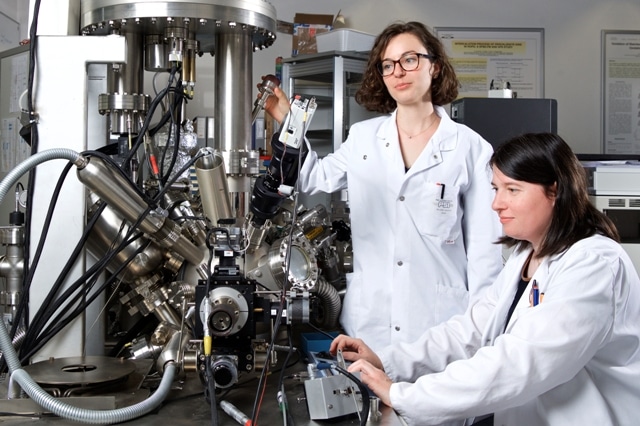Jul 5 2016
A team of materials researchers at the Swiss Paul Scherrer Institute PSI in Villigen and the ETH Zurich have created a highly simple and cost-efficient process for considerably improving the performance of traditional Li-ion rechargeable batteries.
 Juliette Billaud, co-first author of the new study, and Claire Villevieille, head of the battery materials research group at the Paul Scherrer Institute. (Photo: Markus Fischer/Paul Scherrer Institute)
Juliette Billaud, co-first author of the new study, and Claire Villevieille, head of the battery materials research group at the Paul Scherrer Institute. (Photo: Markus Fischer/Paul Scherrer Institute)
The process is scalable in size, so the use of rechargeable batteries will be enhanced across all areas of application including smartphones, laptops, wristwatches, or cars. The capacity of battery storage will be drastically extended, and charging times minimized. The team published their findings in the Nature Energy research journal.
In order to optimize the performance, it is not essential to re-invent the rechargeable battery. Claire Villevieille, head of the battery materials research group at the Paul Scherrer Institute PSI states: In relation to this competitive field, several researchers focus on the creation of new materials. In partnership with colleagues at the ETH in Zurich, Villevieille and co-researcher Juliette Billaud adapted a diverse approach. They analyzed current components with the aim to fully exploit their potential.
Merely by improving the graphite anode – or negative electrode - on a traditional Li-ion battery, researchers were able to increase the performance of the battery. In the laboratory scenario, the team was able to optimize storage capacity by a factor of up to 3. It is not possible for commercial batteries to entirely replicate these results because of their intricate construction. However, performance will certainly be improved, at least by 30 to 50%. Additional experimentation is likely to offer better prognoses.
The team highlights that with regard to industrial implementation, enhancing current components has a great benefit of needing minimal developmental input than a novel battery design with innovative materials.
As Villevieille says: “We already have everything we need.” It just requires a manufacturer to undertake production, and soon optimized batteries will be ready for the market.
The process is scalable, uncomplicated, and cost-effective for use on rechargeable batteries across various applications spanning from wristwatches and smartphones, to laptops and cars. Plus, this has the extra advantage of being transferable to other anode-cathode batteries based on sodium.
Arranging the flakes
Modifying the way anodes function was paramount for the success in this case. Anodes are made from graphite, i.e. carbon, arranged in minuscule, tightly packed flakes, similar in appearance to dark grey cornflakes randomly compressed, as in a granola bar. Lithium ions pass from the cathode, or positive metal oxide electrode via an electrolyte fluid to the anode when a Li-ion battery is charging. They are then stored in the graphite bar.
Likewise, the lithium ions pass back to the cathode when the battery is in use and thus discharging. However, the lithium ions are forced to take several detours via tightly packed mass of graphite flakes, thereby affecting battery performance.
These detours are quite preventable if the flakes are set vertically during the anode production procedure so that they are packed parallel to one another, pointing from the electrode plane in the cathode’s direction.
Making use of a technique already used in the manufacture of artificial composite materials, this arrangement was accomplished by André Studart and experts in the field of material nanostructuration at the ETH Zurich.
The technique requires the graphite flakes to be coated with nanoparticles of iron oxide sensitive to a magnetic field and suspending them in ethanol. The suspended and already magnetized flakes are then subjected to a magnetic field of 100 millitesla — approximately the strength of a fridge magnet.
André Studart describes that by rotating the magnet during this technique, the platelets not only line up vertically but in parallel formation to one another, similar to books on a shelf. Consequently, they are flawlessly ordered, decreasing the diffusion distances undertaken by the lithium ions to the lowest.
Shorter paths for the ions
Microscopic images illustrate that if the magnet stays turned on during the subsequent drying process, the platelets maintain their new orientation even when detached from the ethanol suspension.
Instead of their previously random arrangement, the flakes in the compressed graphite bar are currently parallel, facilitating the lithium ions to flow much more effortlessly and swiftly, and simultaneously also enhancing storage capacity by allowing additional ions to dock during the charging process. Claire Villevieille stresses that the battery’s "chemical composition stays the same". The leftover iron oxide nanoparticles are insignificant in quantity and do not affect battery operation. "All we did was optimise the anode structure".
Source: https://www.psi.ch/